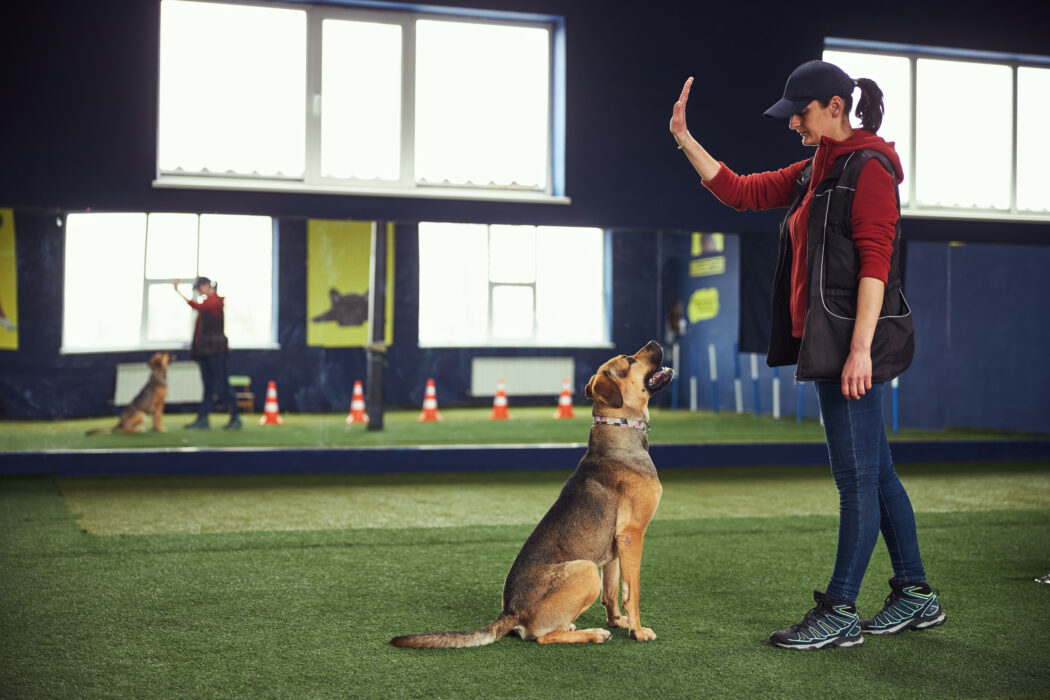The Strong Interest Inventory (SII) identifies six different categories of careers: Realistic, Investigative, Artistic, Social, Enterprising, and Conventional, often referred to as The RIASEC Diagram. Each of these Theme Code Categories contains dozens of careers that share certain features. For example, Realistic careers involve tasks and responsibilities that produce a physical product or a valuable service that improves others’ lives in concrete ways. Animal Trainers, including Dog Trainers, Guide Dog Trainers, Mobility Instructors, and Horse Trainers, are all considered Realistic careers.
Animal trainers teach animals to behave in desirable ways and respond to specific cues or commands to perform particular actions. A typical example is teaching a dog to sit. More complex programs may include training animals to perform tasks that allow them to assist humans in various ways. For instance, Animal Trainers may train guide dogs or service animals to perform tasks such as opening refrigerators, picking up items, turning lights on and off, flushing the toilet, etc. Training also includes general socialization, such as familiarizing young animals with human voices and evaluating young animals to determine whether they may have the right temperament and aptitude for training. Animal Trainers must also teach their animals to accept any equipment used in their care. For example, horses used for riding must learn to accept a harness and saddle, while dogs need to carry their collars and leashes. Those who work with competition or performance animals will also need to teach them any tricks, poses, cues, or keywords they need to execute.

Utilize The Strong Interest Inventory to discover your best fit career today!
In addition to their training responsibilities, Animal Trainers may also need to care for animals, including general care such as feeding, exercising, cleaning, or grooming. If they notice any unusual behavior or physical changes, such as limping, coat shedding, or excessive scratching, they should seek appropriate veterinary care. Most tools and technologies required by Animal Trainers are standard. Scheduling and billing software may be needed to schedule sessions with clients and collect payment afterward. In addition, database software can help track various animals’ progress over time. Tools vary depending on what animals are need training and for what purpose. However, standard equipment typically includes collars, leashes, muzzles, grooming products and tools, protective gear to prevent bites or other injuries, reins, saddles, whistles, and earplugs. Treats and food are also commonly used training tools to reinforce desirable behaviors positively.
Animal Trainers must be in excellent physical shape and have strong manual dexterity and physical strength. They are essentially behavioral specialists, and they also need to be strong communicators and teachers. They teach the animal in their care and its owner, who will likely need to continue or reinforce the training. In most cases, they will also need to use their communication skills to consult with their human client before any training to determine their goals for their animals and what issues need to be corrected. For example, a training session to correct food aggression or guarding may begin with the Animal Trainer asking for specific details about any incidents that may have occurred, the motivation for starting training, and the owner’s perspective of what “success” looks like.
Most Animal Trainers perfect their craft through on-the-job training and apprenticeship programs. According to the Bureau of Labor Statistics, 44% of Animal Trainers hold a high school diploma, 17% have completed some college without having earned a degree, and 23% stopped their education before completing high school.
The median salary for Animal Trainers in the United States is $30,190 annually or $15.16 hourly. In some parts of the country, for instance, in Louisiana, the annual rate is closer to $25,000 annually, while in others like California, the median is over $40,000. Interestingly, Animal Trainer salaries in nonmetropolitan areas are often much higher than in metropolitan areas. For example, in parts of rural Texas, annual salaries average over $70,000, which is in the top quartile of the national data. Rates likely vary depending on the trainers’ expertise and the animals they work with. As of 2020, 60,200 animal trainers were employed in the United States, with a projected growth of over 15% by 2030.
Below are some employment trends for Animal Trainers:
- Median Salary: $30,190 annually
- Employment: 60,200 employees
- Projected growth (2020-2030): Much faster than average (>15%)
- Projected job openings (2020-2030): 9,900
Visit Our Strong Interest Inventory® Resource Page
Visit Our Myers-Briggs Type Indicator® Career Resource Database for Information on MBTI® Personality Type Careers
To Learn More About the Myers-Briggs Type Indicator, visit our About MBTI Test Page
Click on one of these to access more Realistic Theme Code Careers: Acupuncturist, Airline Pilot, Anesthesiologist Assistant, Baker, Barber, Bus Driver, Civil Engineer, Cardiovascular Technologist and Technician, Medical and Clinical Lab Technician, Computer Support Specialist, Game Warden, Forest Firefighter, Heating and Air Conditioning Mechanics, Recreational Protective Service Worker, Meat Trimmer, Molecular and Cell Biologist, Nanotechnology Engineering Technician, Oral and Maxillofacial Surgeon, Pathologist, Plumber, Radiologist, Police Patrol Officer, Surveyor, Telecommunications Engineering Specialist, Veterinarian, Veterinary Technologist and Technician, Welder, Zoologist and Wildlife Biologist.
Explore our Strong Interest Inventory® Blog Pages:
- Strong Interest Inventory Realistic Theme Explained
- Strong Interest Inventory Artistic Theme Explained
- Strong Interest Inventory Investigative Theme Explained
- Strong Interest Inventory Social Theme Explained
- Strong Interest Inventory Enterprising Theme Explained
- Strong Interest Inventory Conventional Theme Explained
References
- Bureau of Labor Statistics wage data and 2012-2022 employment projections Onetonline.org
